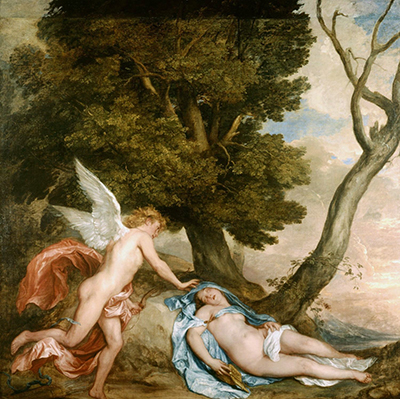Cupid and Psyche was a single element of a larger series of work comissioned by Charles I, though the rest were never completed
Despite calling upon the services of Jacob Jordaens and Sir Peter Paul Rubens to help out Van Dyck, they were still unable to hand over the full project intended for the Queen's House in Greenwich, South East London. The opposing theory is that it was in fact a one off piece to celebrate the marriage of Princess Mary and William II of Orange. The first idea seems to be more believable but it is unlikely will be completely proved or disproved all these years later.
This is a rare mythological scene amongst Van Dyck's oeuvre which typically concentrated on standard portraits of monarchs and their closest connections. There are elements of this painting which look much more detailed than others, perhaps suggesting that it was never entirely finished. It would appear a strange decision for Van Dyck to consciously give more detail to one of the trees in the scene than some of Cupid's curls and feathers unless intending to add to them later on.
The artwork has been dated at around 1638-1640 and may have taken several periods of work to get it to this point. There have been some discussion over whether Psyche was actually modelled by the artist's mistress, Margaret Lemon, although this has never been confirmed either way. As part of the Royal Collection in the UK, one of a number from Van Dyck's career, it is currently on display at Kensington Palace.
A close examination of elements of this painting reveal a clear influence from the work of Titian, someone known to have been a big influence of artist Van Dyck. The Italian master was also popular with Van Dyck's most wealthy donor, King Charles I, who added several of his original works to his collection.
This mythological scene has been captured many times by some of Europe's most famous artists of the Renaissance and Baroque periods, plus more modern eras. They were drawn to the intriguing stories of beauty, love and violence which could generate passionate scenes. Cupid and Psyche can also be found in the careers of the likes of Edward Burne-Jones (Psyche's Wedding), Raphael (The Wedding Banquet of Cupid and Psyche), Orazio Gentileschi, Jacques-Louis David and William-Adolphe Bouguereau (Psyche el L'Amour).




